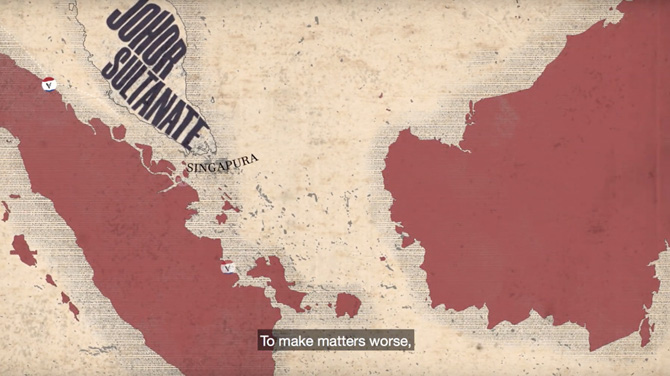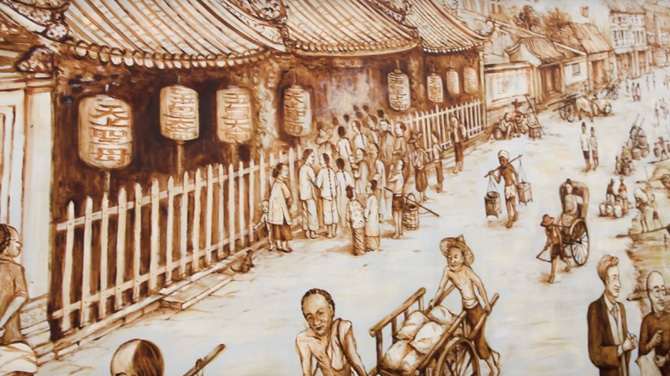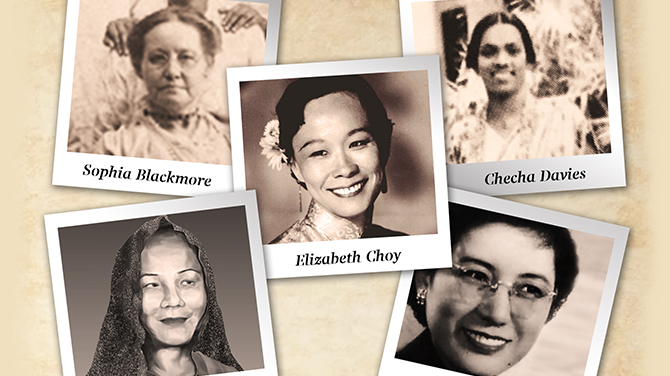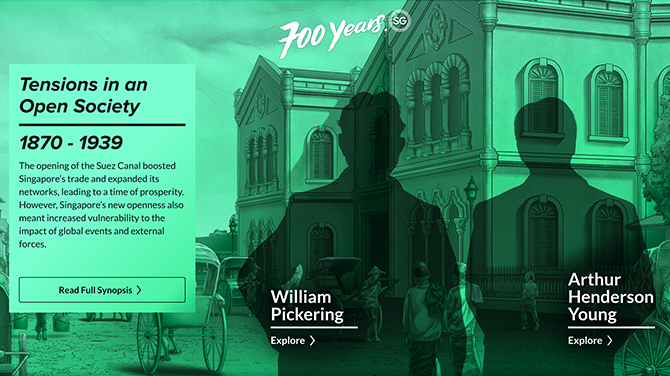
Beyond the Bicentennial Experience, there is a wide spectrum of content that captures our journey before and after 1819 - from a nascent island to a modern metropolis.

After the Japanese surrendered, the British returned and granted Singapore increasing levels of self-governance. In 1965, after a failed merger with Malaysia, Singapore became independent. Since then, the nation has weathered many crises with collective resilience and determination.

































After the Japanese surrendered, the British returned and granted Singapore increasing levels of self-governance. In 1965, after a failed merger with Malaysia, Singapore became independent. Since then, the nation has weathered many crises with collective resilience and determination.








After the Japanese surrendered, the British returned and granted Singapore increasing levels of self-governance. In 1965, after a failed merger with Malaysia, Singapore became independent. Since then, the nation has weathered many crises with collective resilience and determination.








The Japanese Occupation during World War II marked a dark chapter in Singapore’s history. Numerous atrocities suffered by the masses led to local resistance fighters and guerrilla forces rallying together to cripple Japanese war efforts in the region.





























The Japanese Occupation during World War II marked a dark chapter in Singapore’s history. Numerous atrocities suffered by the masses led to local resistance fighters and guerrilla forces rallying together to cripple Japanese war efforts in the region.







The Japanese Occupation during World War II marked a dark chapter in Singapore’s history. Numerous atrocities suffered by the masses led to local resistance fighters and guerrilla forces rallying together to cripple Japanese war efforts in the region.







The advent of steamships, coupled with the opening of the Suez Canal, brought a surge of global trade and new immigrants to Singapore. But this era of rapid industrialisation and diversity was also accompanied by a litany of social ills.


































































The advent of steamships, coupled with the opening of the Suez Canal, brought a surge of global trade and new immigrants to Singapore. But this era of rapid industrialisation and diversity was also accompanied by a litany of social ills.



























The advent of steamships, coupled with the opening of the Suez Canal, brought a surge of global trade and new immigrants to Singapore. But this era of rapid industrialisation and diversity was also accompanied by a litany of social ills.



























Upon signing a treaty with local rulers, Stamford Raffles and William Farquhar established a free port in Singapore that soon flourished. Lured by the promise of work and economic opportunities, various communities from the region and beyond came here to build new lives.




































































Upon signing a treaty with local rulers, Stamford Raffles and William Farquhar established a free port in Singapore that soon flourished. Lured by the promise of work and economic opportunities, various communities from the region and beyond came here to build new lives.






























Upon signing a treaty with local rulers, Stamford Raffles and William Farquhar established a free port in Singapore that soon flourished. Lured by the promise of work and economic opportunities, various communities from the region and beyond came here to build new lives.






























Powerful empires in the Southeast Asia jostled to subjugate port cities including Singapura, in attempts to gain dominance over maritime routes. Political intrigues and epic battles influenced the fate of Singapura as it rises and falls.

































































Powerful empires in the Southeast Asia jostled to subjugate port cities including Singapura, in attempts to gain dominance over maritime routes. Political intrigues and epic battles influenced the fate of Singapura as it rises and falls.

























Powerful empires in the Southeast Asia jostled to subjugate port cities including Singapura, in attempts to gain dominance over maritime routes. Political intrigues and epic battles influenced the fate of Singapura as it rises and falls.



























The Sejarah Melayu (Malay Annals) is often hailed as a seminal text for the world of Malay literature. What do its myths and narrative arcs within, including that of legendary strongman Badang, tell us about the history of early Singapore? Discover the value of this historical manuscript in this e-book by Nazry Bahrawi.

Two kingdoms vie for power over the Malaccan Straits: The Johor Sultanate under Sultan Alauddin Riayat Shah III, a rising power in the east born from the ashes of Melaka, and the Aceh Sultanate led by Iskandar Muda, made mighty by dint of its military and wealth from trade.

Aditya left her village in Java to join her husband in the bustling new port town of Singapura. Tragedy strikes, and she is left to face the biggest choice she will ever make. Discover colonial Singapore through the perspective of a female immigrant in this tale of hope and faith by Melissa De Silva.

Two historical buildings stand in our city centre—Istana Kampong Glam was the Sultan’s palace and the heart of a port town with roots dating back to the 14th century; Thian Hock Keng was a later addition, a Hokkien temple whose building style has not stopped evolving since 1839.

Before Mandai Zoo, Ah Meng and Inuka, there was Ponggol Zoo, William Basapa aka “Animal Man” and Apay the tiger. In the face of World War II, this zoo in the North East had to close and many of its animals were shot. This E-book recounts this and other disappearances.

The first road leading up to Bukit Timah Hill was completed in 1843. By the turn of the century, in 1903, the North West of Singapore was served by an inland railway line. These were days when boats used by the Orang Laut co-existed with mosquito and trolley buses.

Before the East Coast Reclamation project, coconut trees lined Bedok Road. A Katong-Bedok bus service plied coastal roads, servicing the kampongs and estates in the South East. Malay and Chinese fishermen lived off the sea, and farmers grew produce that they brought to markets like Chai Chee.

A magnificent pheasant performs an age-old ritual of a mating dance, but falls into a water trap, coming close to drowning. Will his booming call for help attract the attention of his friends? This book is populated by beautiful creatures from The William Farquhar Collection of Natural History Drawings.

Behind each family name and business brand is a story of strength, adaptability, and resilience. From egg tarts to medicated oils, the families and businesses featured tell of the diversity of migrant beginnings and memories that make up our collective history. Delve into ocean crossings, and the legacies of illustrious forebears through stories collected by the Singapore Bicentennial’s volunteer story documenters.

Crocodiles have existed here for over 200 years. Once considered territorial protectors, these creatures have fallen prey to eradication under the colonial government, a booming international skin trade and habitat destruction. Unfold their history and discover how the ‘predator and prey’ dynamic unravels into parallel and colliding paths of co-existence.

The story of philanthropy in Singapore can be read in books and historical documents, and seen in her built environment. Through this e-book, uncover the diverse, vibrant and larger-than-life stories behind monuments such as Sri Mariamman Temple, Masjid Omar Kampong Melaka and Tan Tock Seng Hospital.

Delve into this memoir of Dr Lim Boon Keng, written by his great-granddaughter Stella Kon. Compiled from her fragmentary childhood memories with reminiscences of her father, Dr Lim Kok Ann, the memoir also draws on research for her new work, Lim Boon Keng - The Musical.

There was a point in time where pilgrims in the region sought the help of sheikh hajis to prepare for their journey across seas to fulfill the fifth pillar of Islam – the Hajj. Through this e-book, discover Singapore as a historical and cultural waypoint for this transnational religious experience.

A farmer joins Dalforce, a volunteer army formed to fight against invading Japanese forces during World War II. Follow his poignant journey as he sets off for training and gets deployed in the mangrove swamps of Woodlands. Written and illustrated by Weng Pixin, this action comic spins a story around the battle at Kranji Beach in 1942.

2050, Singapore: Climate-regulating clothes, flying driverless vehicles, and virtual concierge animal companions. In this world, which she barely recognises, Popo stays at home and watches re-runs of Game of Thrones. Enter Ollie her granddaughter and her genius scientist of a daughter, who take her out on an unforgettable birthday excursion.






























